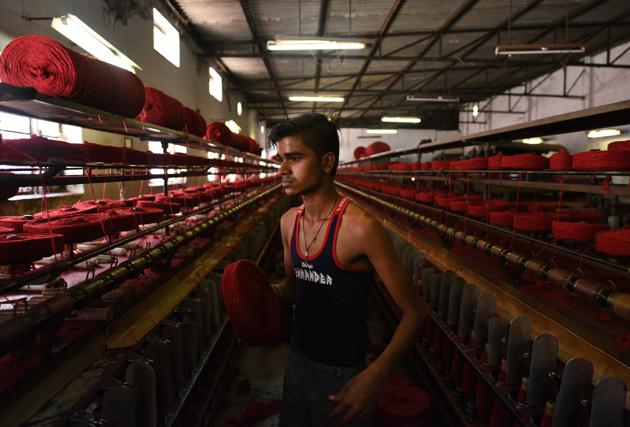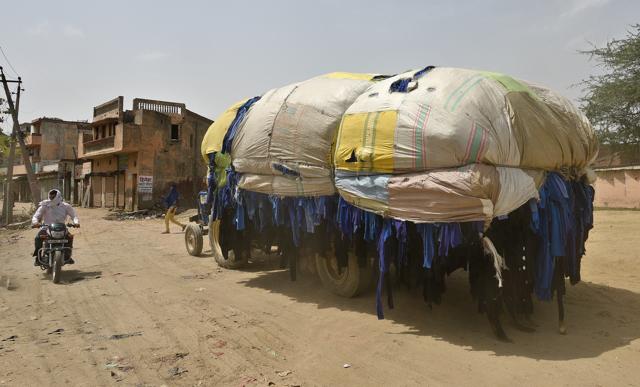In Panipat, the world’s ‘castoff capital’, business hangs by a thread
For decades, the West’s discarded winter wear has come here to be ripped apart and reborn as cheap, warm blankets. Now, a new type of Chinese fleece is threatening to make them obsolete.
The streets of Panipat are lined with cloth; trucks bursting with the stuff lumber along them. Step closer and the cloth turns out to be shredded woollen scrap, ready to be turned back into a type of yarn called shoddy.

This is the castoff capital of the world. Woollen clothing from the US, Canada, the UK, Western Europe, Japan and Korea is brought to this town in Haryana to be resold, recycled and reused.
Most of it is turned into shoddy yarn, and used to make coarse blankets that are sold very cheap but are exceptionally warm. At one point, Panipat accounted for 90% of the shoddy blankets used worldwide — most of it in disaster relief, some of it sold domestically, for use in rural UP, Bihar and Rajasthan, where the winters are fierce.
Ask for directions to Panipat’s shoddy factories today, though, and you get confused frowns. “Factories to bandh ho rahe hein. Aap jaakar kya karoge,” said one passerby. “The factories are closing. What’s the point of going there?”

Soft landing
It’s a fair point. The factories have dwindled in number from about 400 in the early 2000s to 100 today. Production is now at 300 tonnes of yarn a day, down 25% from 2008.
“There was a time when Panipat’s roads used to be blocked by lines of trucks, carrying tonnes of clothes to the factories,” says Pawan Garg, president of the All India Woollen & Shoddy Mills Association. “The trucks can still be seen, but they don’t cause traffic jams anymore.”
The falling numbers can be traced all the way to China, where a new type of artificial fleece is being used to churn out soft, new blankets from virgin polyester yarns.
Where the blankets made from shoddy are rough, coarse and usually brown or grey — in addition to disaster relief, they are used by the Indian Railway and in government hospitals — the Chinese blankets are light, soft and come in a variety of colours. Worst of all, for Panipat, the Chinese blankets are cheaper.
Fleece blankets cost between ₹80 and ₹250 each; shoddy between ₹70 and ₹300.
“How can we compete with that?” says Ashwini Kumar, 59, co-owner of a 30-year-old shoddy mill in Panipat. “The moment you see and touch the Chinese fleece, the shoddy blankets fall short. They’re heavy, rough.”
Prato’s decline
The hundred factories are holding on because there is some demand from the disaster-relief segment. “But even aid organisations have started to reject our shoddy, saying it’s not soft enough or light enough,” says Garg. He believes the end is near.
It’s been more than 50 years since Panipat acquired the status of castoff capital. It was a tag held, before that, by Prato, an industrial city in Italy.
Ironically, it was low-cost alternatives in the Indian subcontinent that led to Prato’s decline. Recycling units here began to use the same machines to offer a competitive product at prices that were far lower, because of lower labour costs here.
Woollen clothes previously exported to Prato began to find their way to India, Pakistan and Bangladesh. “In India, as Panipat was a spinning centre with a history of working with woollen yarn, so the recycled clothes started coming here, via the Kandla port in Gujarat,” says Garg.
That’s the route they still take today, but with production falling, only half as many castoffs are being imported.

A walk through the 30-year-old Shankar Woollen Mill is a reminder of how thing used to be. Piles of mutilated woollen clothes stand 10 ft high across the 20,000-sq-metre space.
Most have already been sorted into the basic colour families of gray, red, blue, camel and green — the colour of most winter clothing in the West.
At each pile, five or six workers are ripping out zips, buttons and linings. Others are shredding the clothes with special slicers.
“The clothes are then put into rag-pulling machines, from where they emerge as uniformly coloured fluff; then soaked in oil for conditioning; re-conditioned; pulled apart in a carding machine, and finally twisted into yarn,” says Surender Gupta, 64, owner of the mill.
The constant activity, the hum of the machines can give you a false sense of success, he says.
“The reality is that in the last two years, our shoddy yarn business has fallen by half. Two years ago, we were importing 100 tonnes of clothes a month. Today, it has reduced to 50. The demand is less. We have also sold one of our three machine sets,” Gupta says.

Coming unspooled
Where the fleece blankets cost between ₹80 and ₹250 each, blankets made from shoddy cost ₹70 to ₹300
There are now 100 shoddy mills in Panipat, down from 400 in the early 2000s
Where the mills employed 25,000 people in 2008, they employ 7,000 today
(Source: All India Woollen & Shoddy Mills Association)
Some factories are staying afloat by switching to the Chinese fleece. Birmi International, set up in 1992, was one of the first to make the move, in 2010.
“If you can get a better product at a lower price, why wouldn’t you buy it?” says owner Pankaj Bansal. “The shoddy industry is in the ICU because of product failure. It is basically of inferior quality. I think everyone will eventually switch to fleece. It is the future of our industry.”
Where he once bought used clothes and turned them into yarn, he now buys virgin polyester yarns and, using machines bought in China, turn them into fleece blankets.
The local fleece blanket industry also faces competition from imported Chinese blankets. “But as the quality is almost the same, the competition is healthy,” Bansal says. “We also don’t do year-round production any more. Our production cycle goes from August to January, to coincide with winter demand.”
Other units are trying to survive by diversifying into cotton yarn.

“There are now about 50 cotton yarn units in Panipat. They started coming up 10 years ago,” Garg says. “Cotton yarn is easier to produce; the capacity of each unit is more. The yarn in used in the handloom and home furnishing industries.”
Garg’s own factory, Swastika Spinning Mills, has also diversified into cotton yarns. “Cotton yarn is a logical step for us,” he adds. “The shoddy yarn industry has lost its sheen.”
The association had submitted a representation to the Centre on February 1, regarding the issue of fleece blankets affecting the business. “I plan to take it up with the union minister and ensure something is done to make the environment feasible for the continued existence of the industry,” says Vipul Goel, state minister in charge of industries and commerce.
Meanwhile, it doesn’t help that production costs are rising, even as demand tanks. “Transportation and storage are becoming more expensive, so is power supply and labour,” says Kumar.
“Where five years ago, the yarn would cost about ₹20 per kg to make, it now costs about ₹30. Little things like the paper tubes around which the yarn is wrapped and the bags in which it is transported have doubled in price. No one can save this industry.”






